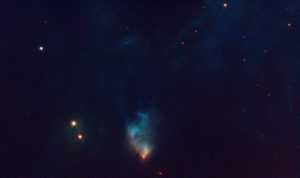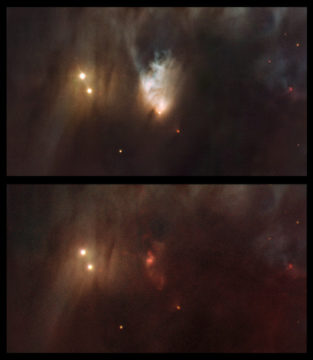Now you see it, now you don't. McNeil's Nebula in Orion has disappeared, thanks to a drastic reduction in brightness from the protostar that usually provides illumination.

ESO
There’s an intriguing class of objects out there known as variable nebulae (S&T: Feb. 2018, p. 22), the most famous of which is probably Hubble’s Variable Nebula. They’re primarily reflection nebulae illuminated by variable stars, with variations in brightness occurring on timescales as short as weeks or months.
On January 23rd, 2004, amateur astronomer Julian “Jay” McNeil discovered a new nebula with a 3-inch refractor from his backyard in Paducah, Kentucky. He spotted it in a CCD image he had taken of the familiar reflection nebula M78 in Orion. Although not visible in several photographic plates dating back to 1951, this new nebula is present in one image from 1966, providing early hints of its variability. By the time of McNeil’s discovery, the nebula had not yet been cataloged.
McNeil’s Nebula, as it came to be called, is illuminated by the outbursting protostar V164 Orionis. Protostars of this kind are prone to eruptions as the young stellar object evolves into a full-blown star, and it is these eruptions that illuminate the surrounding nebula. Some protostars may even undergo these eruptions periodically.
So when McNeil’s Nebula was identified in 2004, astronomers both amateur and professional anticipated that it would fade and then rebrighten around 2042, based on the interval during which it was dark between 1966 and 2004. In fact, the nebula astonished observers with another brightening episode in 2008. To this day, even though the nebula's brightness has varied, it hasn’t disappeared entirely from view since 2004.
Until now, that is.

ESO / A. Rector / Univ. Alaska Anchorage / H. Schweiker / WIYN / NOAO / AURA / NSF / I. Chekalin
On November 5th, British astronomer Mike Harlow of the Orwell Astronomical Society of Ipswich, observing with the University of Iowa’s 500-mm Gemini telescope, noted that McNeil’s Nebula had disappeared. Nick Hewitt of the British Astronomical Association issued a report the following day (thanks to Callum Porter for alerting Sky & Telescope to this report).
S&T contributing editor Ted Forte was also observing on the night of November 3rd from his backyard observatory outside of Sierra Vista, Ariz. He noted conditions of average transparency, better-than-average seeing, and a typical sky brightness of 21.38 magnitudes per square arcsecond. He pointed his 30-inch f/4.45 Dobsonian at M78 to verify that the alignment was correct. Being the dedicated and enthusiastic deep-sky observer that he is, Ted poked around to see if he could spot McNeil’s Nebula, as he was in the habit of doing whenever he pointed his scope at M78. He, too, didn’t detect the nebula.
Who knows when McNeil’s Nebula will be illuminated again? Will it surprise us by reappearing in a few weeks (or months)? Will we have to keep monitoring that spot for years before it decides to show itself again? Or have we seen its last puff, never to be seen again?
In the words of Ted Forte: “Isn’t that what makes observing fun?”
 0
0









Comments
You must be logged in to post a comment.